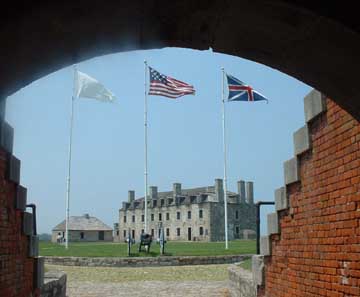
Old Fort Niagara controlled
the mouth of the Niagara River for a century and a half. Its strategic location
made it desirable by the French, the British, and the Americans.

Cobblestone Buildings
are fairly common in Niagara Country. They were made from round stones from
a lake that existed in the closing years of the Ice Age. Most buildings (like
this schoolhouse in Childs) were constructed in the mid-1800s.
|
|
|
|
Niagara Frontier:
The
Geography of the Borderland
The term frontier is loaded with geographic connotations.
One might be picture the Wild West, a scene of bloody conflict, or perhaps
a region isolated from civilization. Western New York has, at different
times of its history, qualified on all three counts. Today, the borderland
is relatively peaceful, with relations with Canada on a more-or-less friendly
basis. If we go back far enough, however, peace was only a promise. Native
Americans fought each other. They fought the French and the British. The
French fought the British. The Americans fought the British. American "patriots"
fought American "loyalists." It wasn't until the 19th century before warfare
became but a distant memory in the Niagara Country.
Why this became a borderland can only be explained from
a geographic perspective. The boundary here is not an arbitrary line
on a map, like a Mason-Dixon line, for example. The two Great Lakes
- Ontario and Erie - are two formidable obstacles, and so
is the river that connects them, the mighty Niagara. These obstacles
help separate "us" from "them." After the American Revolution, it made sense
for Loyalists to the Crown to settle on the other side of Niagara and form
the future nation of Canada. And, of course, the patriotic rebels formed
our own nation on this side of the border.
Control of this region was very important even before Columbus.
The Haudenosaunee (or the Iroquois, as we know them) were in constant
warfare with other native peoples (such as Hurons, for example). Controlling
access to Niagara was critical to their survival. When the French and
British fought each other over control of North America, this was a pivotal
point. The Falls of Niagara presented the greatest challenge. If you were
going west into Ohio or Michigan, you had to get by the cataracts. Control
of the river from its source near modern Buffalo to its outlet in Lake
Ontario 35 miles downstream was mandatory. Even when the French were driven
out, and the United States was born, the turmoil did not end. The War of
1812 was largely contested here along the Niagara Frontier. The boundary
became demilitarized, but unrest continued: the Underground Railroad, Irish
rebels, Confederate sympathizers, Vietnam draft dodgers all found their
way to this frontier.
When most Americans think about the Niagara Country, it is, of course,
as the home to the Falls, the great geological wonder, the original American
(and Canadian) circus playground. They may speak of the power of electricity,
which ushered in the modern age for better or worse. And, sadly, they
will refer to the Rust Belt, of cities and towns suffering the loss of
factories and people. The fact that the Buffalo Bills lost four consecutive
Super Bowls is a constant source of derision. All of these perceptions
are part of the collage of Western New York, but there is much more.
Let us try to examine the Niagara Country more closely. Hit the road!
|
|
|
|
|
If you are going to travel through the Niagara Country, then follow this
link to find out "What You Should See."

Go to the next section!
|
|
|
|





